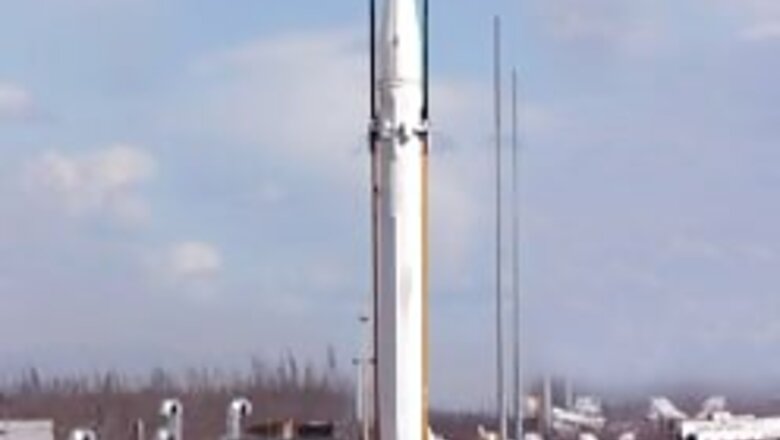
views
Tokyo: Japan and the US have agreed to deploy advanced Patriot interceptor missiles on US bases in Japan for the first time, officials said Monday, amid concerns that North Korea may test-fire a long-range ballistic missile.
The two sides reached the accord earlier this month and intend to install the weapons as early as possible, a Defense Agency spokeswoman said on condition of anonymity.
The plan will put Patriot Advanced Capability—3 missiles designed to intercept ballistic missiles, cruise missiles or enemy aircraft –on US bases in Japan for the first time.
A news report, however, said the PAC-3 may be unable to hit North Korea's latest long-range missile.
The Defense Agency spokeswoman said sites and timing for the deployment have not yet been decided.
But a local newspaper reported that the U.S. military would deploy three or four of the surface-to-air missile batteries on the southern island of Okinawa by the end of the year and send an additional 500 to 600 US troops there.
Up to 16 missiles can fit in a single PAC-3 battery, according to the system's manufacturer, Lockheed Martin Corp.
The plan was proposed by US officials during a June 17 meeting in Hawaii, Japan's largest newspaper Yomiuri Shimbun reported, quoting unidentified government officials.
The two countries signed an agreement in 2005 allowing Japan to produce PAC-3 missiles for deployment during fiscal 2006 at Japanese bases, but the plan to deploy them on US bases is apparently separate.
Recent intelligence reports have said North Korea may be fueling a Taepodong-2, one of its most advanced missiles believed capable of reaching parts of the US, at a launch site on the country's northeastern coast, sparking concerns Pyongyang may soon test-fire one.
However, Japan's defense chief said that it was not clear if fueling is taking place.
Defense Agency chief Fukushiro Nukaga said in a speech delivered in Osaka that while "it appears to be a fact that the missile has been mounted on a launch platform," it was unclear if it was being fueled.
The North had maintained a self-imposed moratorium on such launches since 1999. The United States, Japan and other countries have urged North Korea to halt any plans to test the missile, while Pyongyang has insisted it has the right to do so if it chooses.
PAGE_BREAK
It was unclear whether the PAC-3 would be effective in the current standoff. The PAC-3 is aimed at complementing the Standard Missile-3 installed on Aegis-equipped vessels. But PAC-3, a medium- to long-range interceptor, may be unable to shoot down long-range missiles such as Taepodong-2, the Yomiuri said.
Diplomacy aimed at defusing the standoff, meanwhile, gathered pace. South Korean Foreign Minister Ban Ki-moon was traveling Monday evening to Beijing on a two-day visit to seek China's cooperation in halting any North Korean launch.
"There is a growing need to intensify discussions between South Korea and China on North Korea's recent missile issue and the nuclear issue," the South Korean Foreign Ministry said in a statement.
Ban will meet his counterpart, Li Zhaoxing, as well as Chinese State Councilor Tang Jiaxuan, the ministry said.
China is the North's key ally and is believed able to exert the most influence on Pyongyang. Beijing has also hosted international talks on the North's nuclear program, which haven't convened since November amid a North Korean boycott in anger over U.S. financial restrictions.
Also Monday, a South Korean civic group leader who returned from a trip to Pyongyang said a North Korean official told him there was no reason for his country to fire a missile. The North Korean official wasn't connected to the military and it wasn't clear if his view represented the Government's position.
"Is there any reason for the North to start a new war?" vice chairman of North Korea's Council for Reconciliation and Cooperation, Jong Duck Ki, told a South Korean delegation last week.
In addition to the PAC-3, the missile concerns have prompted the U.S. to move up its planned test of a missile-detecting radar system in northern Japan.
A test-run of the high-resolution radar, capable of detecting incoming missiles, was initially scheduled to begin weeks later. However, testing could start as early as Monday.
Japanese Defense Facilities Administration Agency, in charge of US military bases in Japan, said the report about the radar installation could not be immediately confirmed.
The X-Band radar had been transferred from a US base in Japan to the Japanese Air Self-Defense Force's Shariki base at Tsugaru, in the country's north.
The radar deployment is part of the joint missile defense project, which began after North Korea fired a missile, part of which flew over Japan, in 1998.
Tokyo and Washington on Friday also signed an agreement to expand their cooperation on a joint ballistic missile defense shield, committing themselves to joint production of interceptor missiles.




















Comments
0 comment